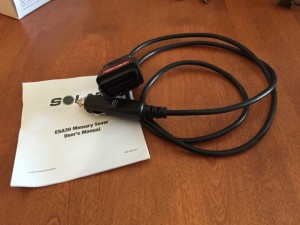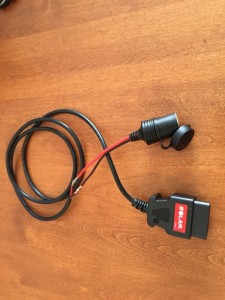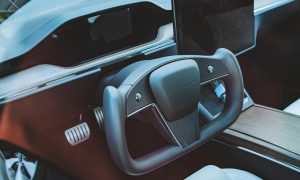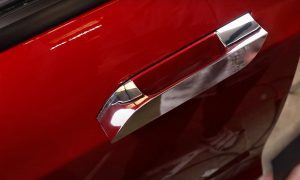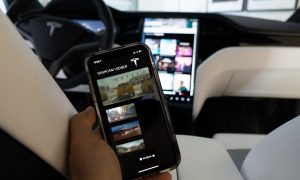DIY
How-To Tap 12V Power from the Tesla Model S
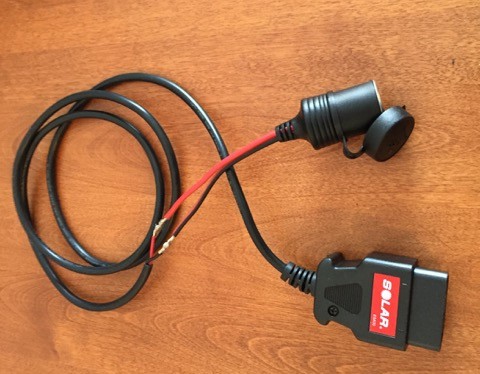
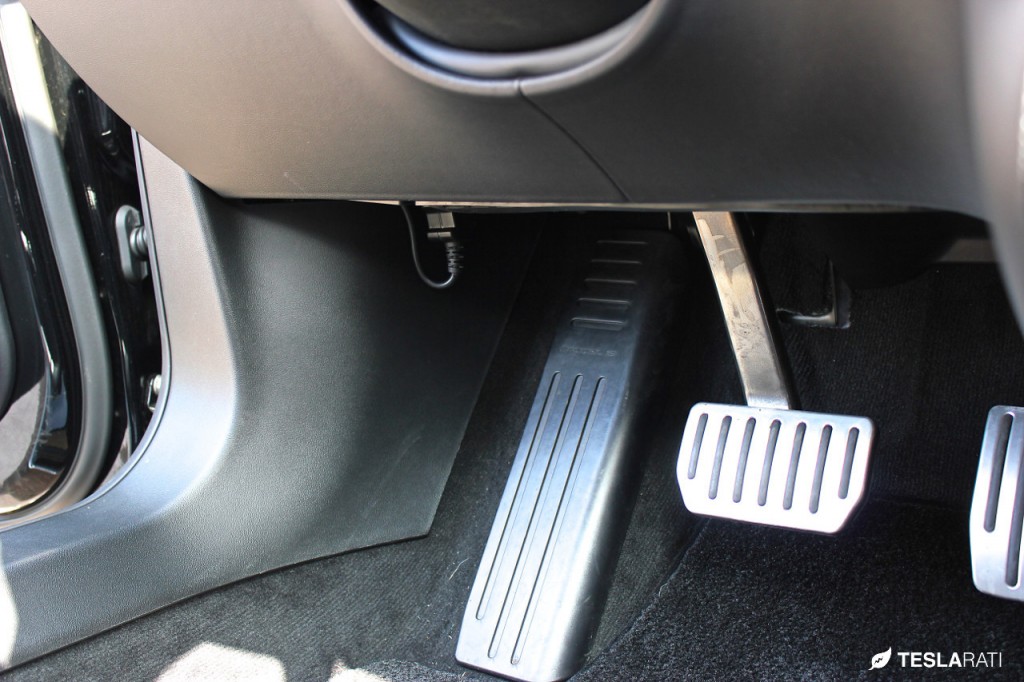
The finished product plugs directly into the OBD-II port of the Model S for a clean and hidden look.
Finding a 12V power supply on the Tesla Model S could be a daunting task considering the variety of methods available for tapping into the vehicle’s wiring system. Some more elegant than others. My most recent Tesla dash cam project had me searching for a constant source of power that’s easy to tap yet removable when needed.
Switched vs Unswitched Power
Personal electronic devices and gadgets used within a car usually require a switched power source that powers devices only when the vehicle is on. Case in point is your cell phone (charging while driving) or a radar detector which only requires power when you’re actually in the car and driving.
However there are times when having access to a constant 12V power source, also known as unswitched power, could come in handy. One example is having an always-on dash cam that acts as a security camera when the car is parked and unattended. It’s the perfect gadget to capture hit and runs and in this case you’ll need a constant supply of power for the camera regardless of whether the car is on or off.
Tesla Model S 12V Power
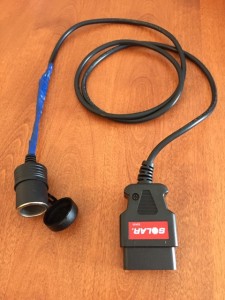 There are four ways in which you can tap into Tesla Model S 12V battery and power your electronic devices.
There are four ways in which you can tap into Tesla Model S 12V battery and power your electronic devices.
- USB Port and 12V Outlet: Plug your device directly into one of the Model S USB ports or 12V (cigarette lighter) outlet. These outlets utilize switched power and will turn off when the car turns off. This is what 99% of Model S owners do because of the convenience with the downside of having to run wire in plain view.
- Tap / Splice Wiring: Find a 12V supply line (usually unswitched) somewhere in the car and splice/tap into it. Older Model S’s (circa 2013) had an extra 12V line tucked up above the rear mirror. Newer ones don’t have that but there are other sources of 12V power that can be tapped into (ie. glovebox lighting, ambient lighting, USB wiring).
- Main 12V Battery: Drill through the firewall and tap directly into the main 12V battery. Be sure to add a fuse onto your new circuit.
- Removable OBD-II Plug: Hack the on-board diagnostics (OBD-II) connector to provide unswitched 12V power.
Hacking the Model S On-board Diagnostics (OBD-II) Connector
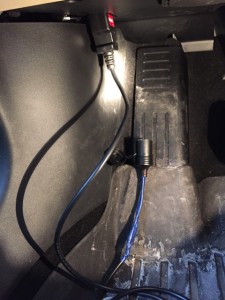 I wanted access to constant 12 power source for my dash cam but at the same time I wanted to ensure that the implementation was 100% reversible. It had to be a simple enough Tesla DIY project that didn’t involve cutting of existing wires or result in a permanent modification. Enter the OBD-II connector.
I wanted access to constant 12 power source for my dash cam but at the same time I wanted to ensure that the implementation was 100% reversible. It had to be a simple enough Tesla DIY project that didn’t involve cutting of existing wires or result in a permanent modification. Enter the OBD-II connector.
Vehicles sold in the US and across much of the world are mandated to have an on-board diagnostics connector (OBD-II). The purpose being it’s a way for service technicians to plug directly into the vehicle’s computer to help diagnose errors and faults within the engine.
Although Tesla has the ability to diagnose the vehicle remotely, they were still required to provide an OBD-II connector on the Model S.
The OBD-II connector on the Model S is located on the drivers side just above the area around the dead pedal. I found this to be the best source for unswitched 12V power.
NOTE: The following steps are to be performed at your own risk. The DIY project is intended to be non-invasive and safe, but it’s also using a component of the Model S for something it was not intended to do. Possibilities of draining your 12V battery, short out your OBD-II connector or cause damage exist if performed incorrectly.
OBD-II to USB Adapter
 If you’re looking for a constant 12V power supply for a USB device, you can purchase a OBD-II to USB adapter.
If you’re looking for a constant 12V power supply for a USB device, you can purchase a OBD-II to USB adapter.
They’re hard to come by and I couldn’t find anyone in the US that made one. But for about $41 delivered you can use the device to obtain a constant USB power supply.
OBD-II to 12V Outlet
This solution starts with a $12 part available via Amazon. It’s intended for a very different purpose — feeding power back into the OBD-II connector via a male 12V power supply when you’re changing batteries. They call these “OBD Memory Savers”.
One end plugs directly into the OBD-II connector of the Model S however the other end is a male plug which needs to be converted into a female plug. The best way to approach this is to purchase any random adapter with a 12V female end to use as a replacement.
Cut the ends off each adapter and then solder the 12V female end to the OBD-II connector — red to red and black to black. Seal the connection with electrical tape.
Parts List
Here’s my parts list and cost to build a completely removable, non-permanent constant 12V source for my Tesla Model S:
- SOLAR ESA30 OBD II Memory Saver Connector
- Roadpro 12V Battery Clip-On and Cigarette Lighter Adapter
- Wire Cutter / Stripper
- 40 Watt LED Soldering Iron
- Electrical Tape
Summary
This nifty little solution helped me tap into a constant 12V power supply for my Tesla dash cam project without having to leave a permanent mark, but also do it in under $20. Simple and completely removable. Just keep in mind the note from above – take caution when plugging anything into a constant source of 12V power since you can drain the 12V battery if left unattended.
DIY
Tesla Model 3 pickup “Truckla” gets updates and a perfectly wholesome robot charger
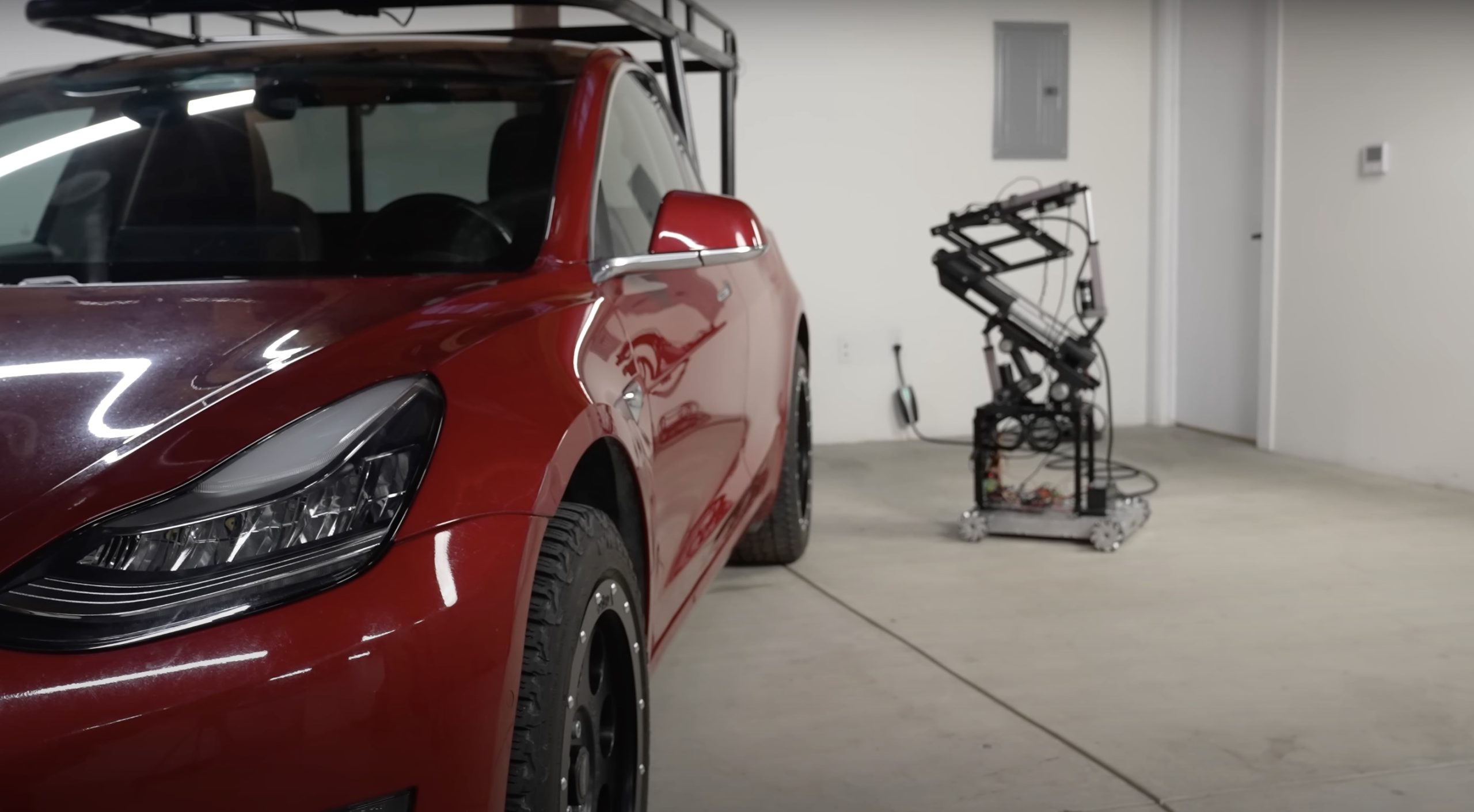
Back in 2019, YouTuber Simone Giertz, the self-proclaimed “Queen of Sh*tty Robots,” created a one-off Tesla Model 3 build that took the automotive world by storm. Fondly dubbed as “Truckla,” Giertz noted that the vehicle was actually her dream car — as crazy as that may sound.
Now almost four years later, the YouTuber posted an update on Truckla. And just like every other big project that one probably started, Giertz stated that she actually stopped working on Truckla when the vehicle was about 80% complete. The car is driving though, but a lot of stuff was not really working very well.
Thus, for her Truckla update, Giertz shared how most of her Model 3 pickup truck conversion was essentially completed. Truckla got a lot of detailing done, she got a slight lift, and she now has a functional tailgate. One has to admit, Truckla’s tailgate is pretty darn cool.
The “Queen of Sh*tty Robots” also opted to give Truckla a friend in the form of an automatic robot charger. Unlike Tesla’s rather interesting snake charger from years past, Truckla’s charger would come in the form of a rover, thanks to her friends at robotics platform Viam. Giertz aptly named Truckla’s robot charger friend “Chargela,” which is an appropriate name for such an invention.
Also true to form for Giertz, Chargela’s first encounter with Truckla was just a tiny bit awkward. One could say that Chargela may have just been a little bit nervous on his first try without human hands helping him. Most importantly, the system did work, so Giertz would likely keep using Chargela for her Model 3 pickup.
Teslas are very tech-heavy vehicles, so projects like Giertz’s Truckla are always remarkable. The fact that the Model 3 works perfectly fine despite having a good chunk of it cut off and turned into a pickup truck bed is mighty impressive any way one looks at it. Overall, Truckla will always be one of the coolest Tesla DIY projects to date, so any updates about the vehicle are always appreciated.
Truckla’s nearly four-year update can be viewed below.
Don’t hesitate to contact us with news tips. Just send a message to simon@teslarati.com to give us a heads up.
DIY
Tesla fan creating ‘CyberRoadster’ using Model 3 Performance parts in epic DIY build
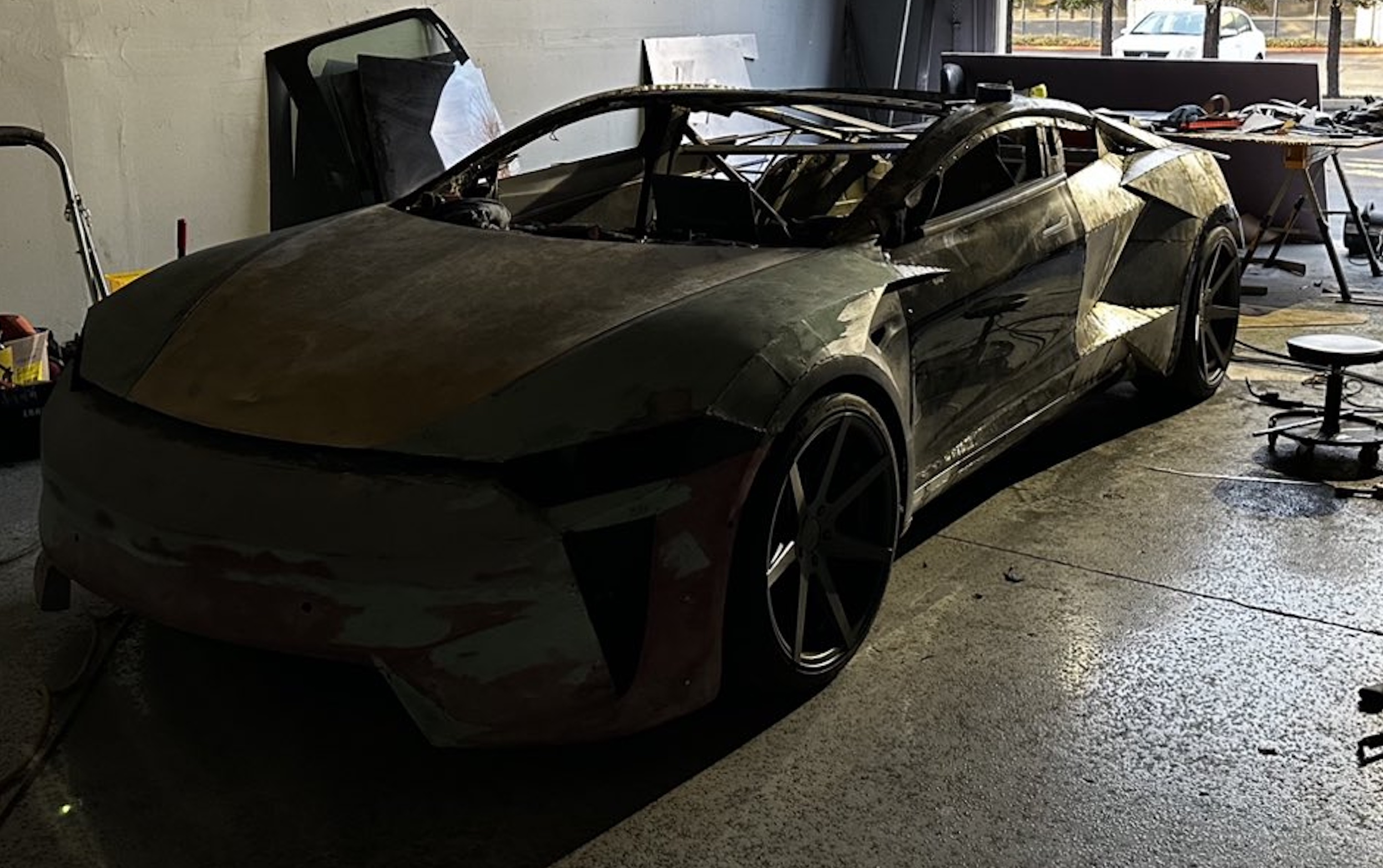
A Tesla owner is taking his hobby and love for electric vehicles to new levels by creating what could only be described as one of the coolest EV-related DIY projects to date. The idea for the project is simple: what happens when you cross a supercar with the Cybertruck? You end up with a two-seater CyberRoadster.
Tesla owner David Andreyev, who goes by the username @Cyber_Hooligan_ on Twitter, has spent the last few months creating a Cybertruck-inspired version of the next-generation Roadster made from a salvaged Model 3 Performance. Starting with a Model 3 Performance is an inspired choice, considering that it is Tesla’s first vehicle that has a dedicated Track Mode.
A look at Andreyev’s YouTube channel, which can be accessed here, shows the meticulous build that the Tesla owner has implemented on the project car. What’s particularly cool about the CyberRoadster is the fact that it’s being built with parts that are also from other Tesla vehicles, like its front bumper that came from a new Model S. Recent videos suggest that the project car’s rear bumper will be from a new Model S as well.
The journey is long for Andreyev, so the completion of the CyberRoadster will likely take some more time. Despite this, seeing the Tesla owner’s DIY journey on such an epic build is more than satisfying. And considering that the CyberRoadster is evidently a labor of love from the Tesla owner, the final results would likely be extremely worth it.
There’s a lot of crazy Tesla modifications that have been done as of late. But some, as it is with a lot of things on the internet these days, have become more silly gimmicks than serious automotive projects. Fortunately, car enthusiasts like Andreyev, who just happen to also love electric vehicles, are taking it upon themselves to create one-of-a-kind EVs that would surely capture the attention of anyone on the road.
Check out the latest video in the CyberRoadster’s creation below.
Don’t hesitate to contact us with news tips. Just send a message to simon@teslarati.com to give us a heads up.
DIY
Tesla owner ‘charges’ Model 3 with homemade solar panel trailer
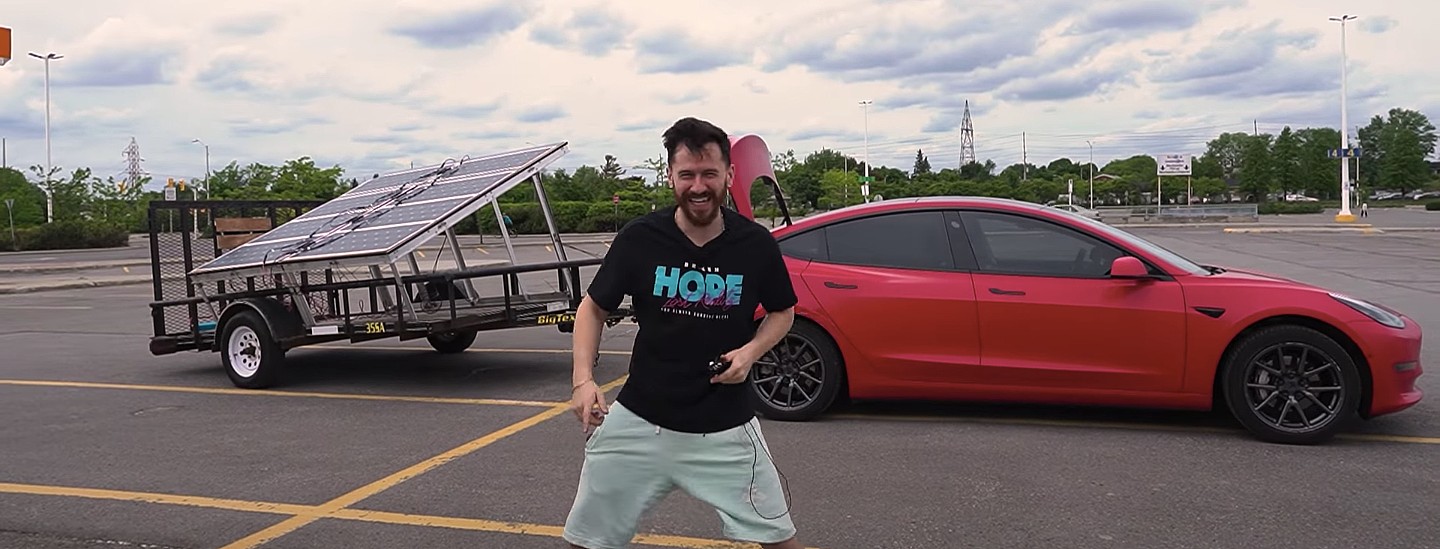
A Tesla owner has demonstrated a rather novel way to charge his Model 3. In a recent video, Sean Callaghan of the ItsYeBoi YouTube channel opted to use a series of off-the-shelf solar panel sheets onto a towable trailer to create a mobile charging unit for his all-electric sedan.
Callaghan planned to use only the sun and the solar sheets purchased from e-commerce platform Wish to charge his Model 3. The solar panel sheets would collect energy from the sun and transfer it to a control panel. The control panels were connected to batteries that would hold the energy—the batteries connected to an inverter, which would then charge the Tesla Model 3.
The entire assembly would provide the Model 3 with about 800 watts of energy on a completely sunny day. However, Callaghan shot the video when weather was overcast, so the entire solar panel trailer build only managed to provide around 300 watts throughout the YouTube host’s test.
To put this into perspective, a 100 volt home wall outlet provides 1.4 kilowatts of power, or 1,400 watts. Therefore, the 300-watt solar panel assembly built by Callaghan was producing less than 25% of the energy of a typical wall outlet. This is pretty marginal compared to Tesla’s 250-kilowatt V3 Superchargers, which provides 250,000 watts, or about 833 times as much power as the makeshift solar panel build.
However, Callaghan’s goal was not to charge the vehicle quickly. He explained the idea came from a previous video where he used a $5,000 Wish-purchased wind turbine to charge his Model 3. He wanted to test the effectiveness and efficiency of the system, which was questionable due to the time it would take to charge the battery fully.
The Model 3 battery pack is 78 kWh, and with Callaghan’s 300-watt system charging his electric vehicle, it would take 260 hours to supply the Tesla’s battery to full capacity.
In the past, electric vehicle enthusiasts have asked Tesla CEO Elon Musk why the company’s vehicles do not contain solar glass roofing, which would charge the car while the owner is driving. Musk has explained that the efficiency of this idea is challenging and likely would not provide an ample amount of range.
When asked about the idea of putting solar panels on the top of Tesla’s vehicles in 2017, Musk responded that the idea was “Not that helpful, because the actual surface of the car is not that much, and cars are often inside. The least efficient place to put solar is on the car.” It also would not be cost-effective for Tesla because “the cost of the panels and electronics, R&D and assembly would never pay for itself in the life of the vehicle, compared to charging from the wall in your garage,” Quartz noted.
That being said, Tesla plans to implement solar panels onto the motorized tonneau of the upcoming Cybertruck. The idea was discussed on Twitter when Musk stated that the optional feature would add “15 miles per day, possibly more” when parked in the sunlight. Also, fold-out solar wings could help capture enough solar energy for 30 to 40 miles a day.
Watch Sean Callaghan’s video of his makeshift solar panel trailer below.
-

 Elon Musk2 weeks ago
Elon Musk2 weeks agoTesla investors will be shocked by Jim Cramer’s latest assessment
-

 Elon Musk3 days ago
Elon Musk3 days agoxAI launches Grok 4 with new $300/month SuperGrok Heavy subscription
-

 Elon Musk5 days ago
Elon Musk5 days agoElon Musk confirms Grok 4 launch on July 9 with livestream event
-

 News1 week ago
News1 week agoTesla Model 3 ranks as the safest new car in Europe for 2025, per Euro NCAP tests
-

 Elon Musk1 week ago
Elon Musk1 week agoxAI’s Memphis data center receives air permit despite community criticism
-

 News2 weeks ago
News2 weeks agoXiaomi CEO congratulates Tesla on first FSD delivery: “We have to continue learning!”
-

 News2 weeks ago
News2 weeks agoTesla sees explosive sales growth in UK, Spain, and Netherlands in June
-

 Elon Musk2 weeks ago
Elon Musk2 weeks agoTesla scrambles after Musk sidekick exit, CEO takes over sales

